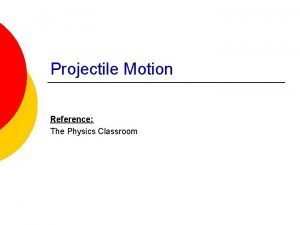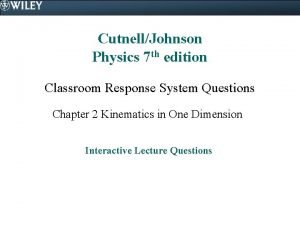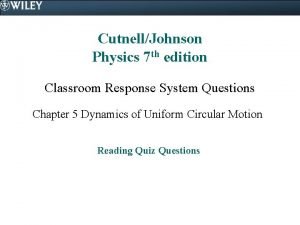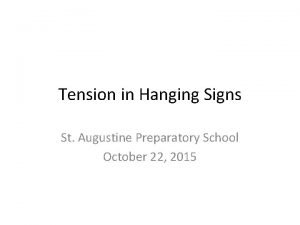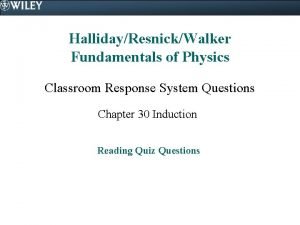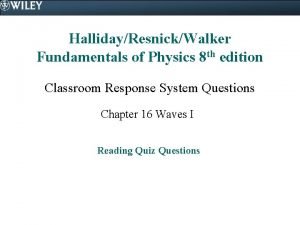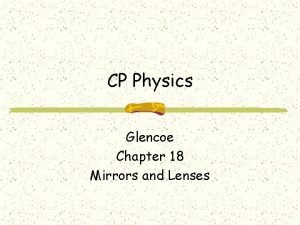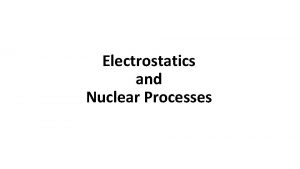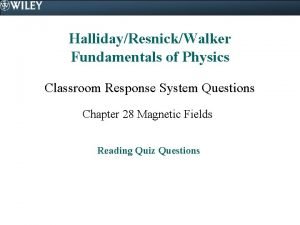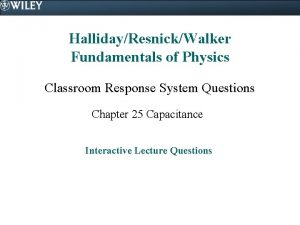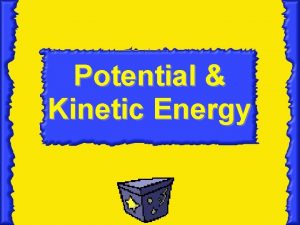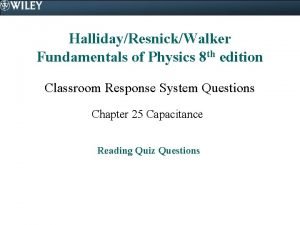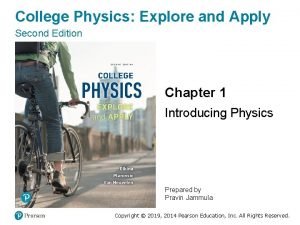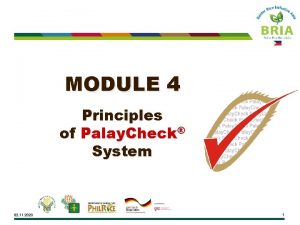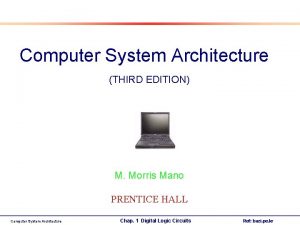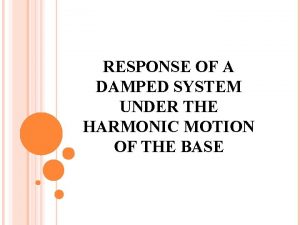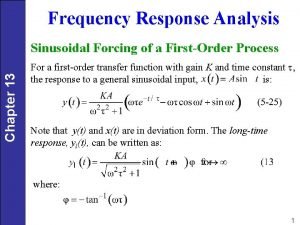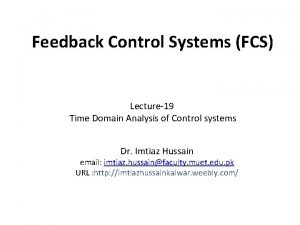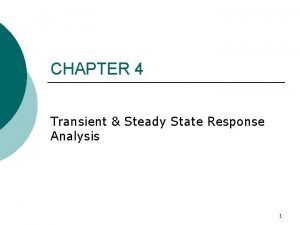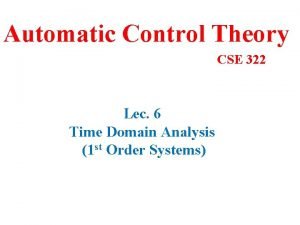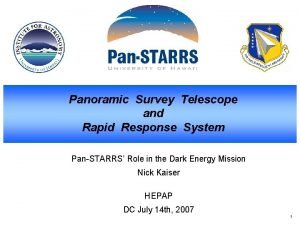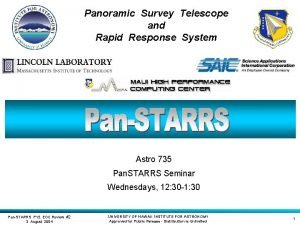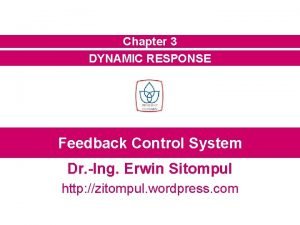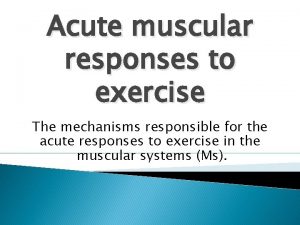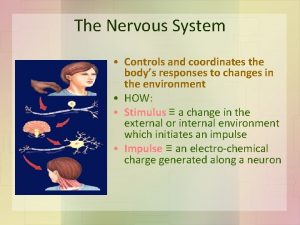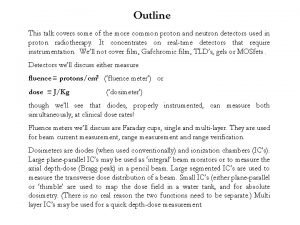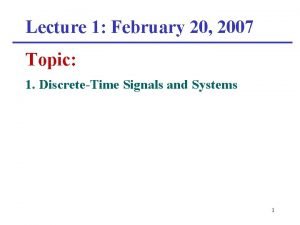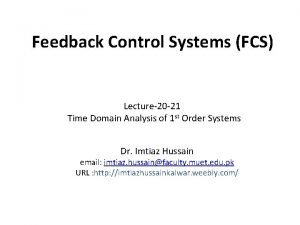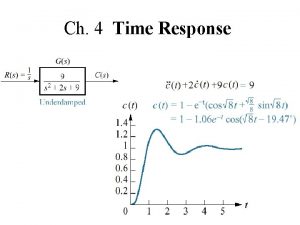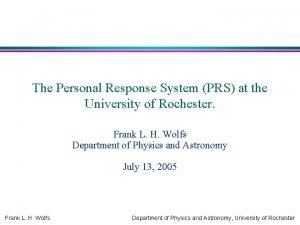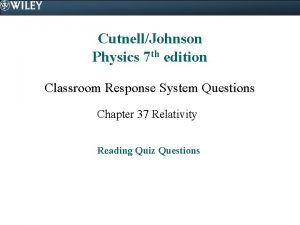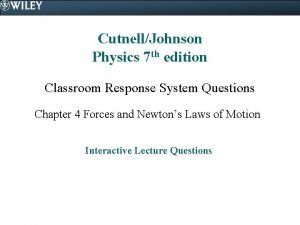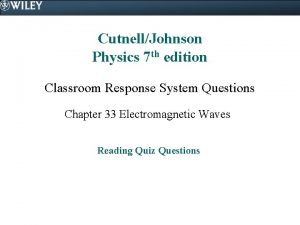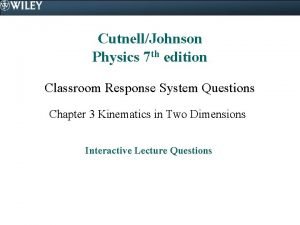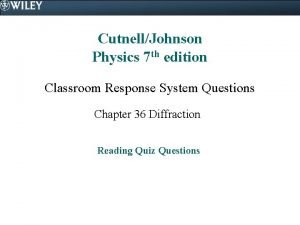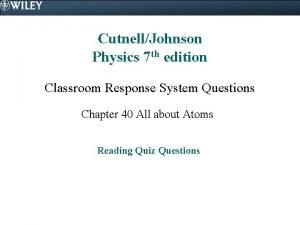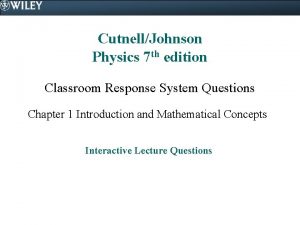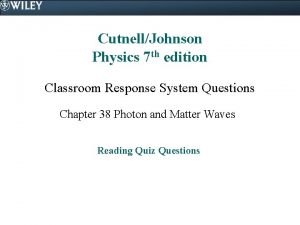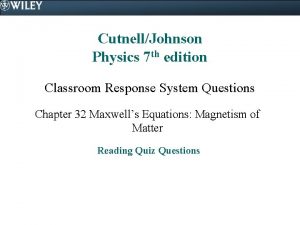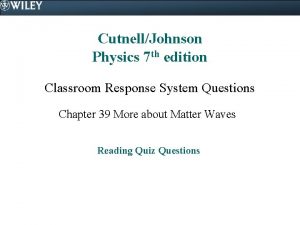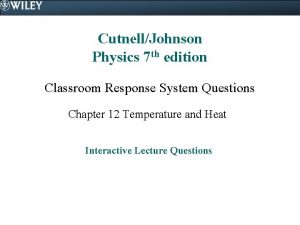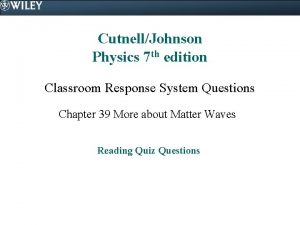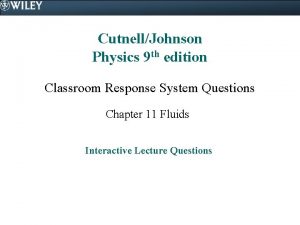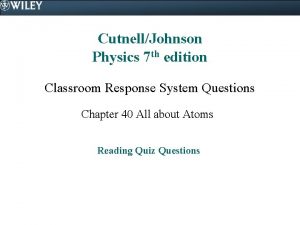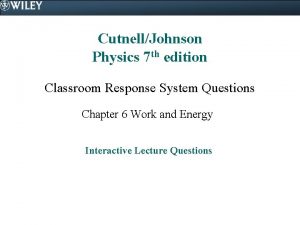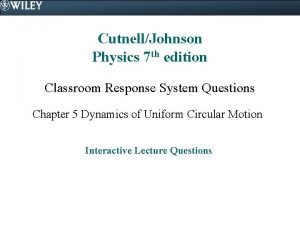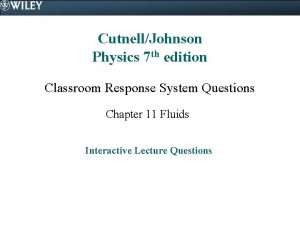CutnellJohnson Physics 7 th edition Classroom Response System























































- Slides: 55

Cutnell/Johnson Physics 7 th edition Classroom Response System Questions Chapter 11 Fluids Reading Quiz Questions

11. 1. 1. Which one of the following statements best describes fluids? a) Fluids are liquids. b) Fluids are gases. c) Fluids are transparent. d) Fluids are gases or liquids. e) Fluids are opaque.

11. 1. 1. Which one of the following statements best describes fluids? a) Fluids are liquids. b) Fluids are gases. c) Fluids are transparent. d) Fluids are gases or liquids. e) Fluids are opaque.

11. 1. 2. A cube of a certain metal has 0. 040 -m sides and its mass is 0. 48 kg. What is the mass density of the cube? a) 12 kg/m 3 b) 300 kg/m 3 c) 1800 kg/m 3 d) 7500 kg/m 3 e) 8700 kg/m 3

11. 1. 2. A cube of a certain metal has 0. 040 -m sides and its mass is 0. 48 kg. What is the mass density of the cube? a) 12 kg/m 3 b) 300 kg/m 3 c) 1800 kg/m 3 d) 7500 kg/m 3 e) 8700 kg/m 3

11. 1. 3. The density of mercury is 1. 36 × 104 kg/m 3. What is the mass of a 4. 00 × 10– 4 -m 3 sample of mercury? a) 6. 29 kg b) 5. 44 kg c) 2. 94 kg d) 0. 0343 kg e) 0. 002 94 kg

11. 1. 3. The density of mercury is 1. 36 × 104 kg/m 3. What is the mass of a 4. 00 × 10– 4 -m 3 sample of mercury? a) 6. 29 kg b) 5. 44 kg c) 2. 94 kg d) 0. 0343 kg e) 0. 002 94 kg

11. 2. 1. Which of the following choices is equivalent to the SI unit of pressure, the pascal? a) N/m b) N/m s 2 c) kg/m s 2 d) N/s e) kg m/s 2

11. 2. 1. Which of the following choices is equivalent to the SI unit of pressure, the pascal? a) N/m b) N/m s 2 c) kg/m s 2 d) N/s e) kg m/s 2

11. 2. 2. Which of the following is equal to the pressure of the earth’s atmospheric pressure at sea level? a) 1. 602 × 104 Pa b) 1. 013 × 105 Pa c) 1. 091 × 106 Pa d) 1. 311 × 107 Pa e) 2. 709 × 107 Pa

11. 2. 2. Which of the following is equal to the pressure of the earth’s atmospheric pressure at sea level? a) 1. 602 × 104 Pa b) 1. 013 × 105 Pa c) 1. 091 × 106 Pa d) 1. 311 × 107 Pa e) 2. 709 × 107 Pa

11. 2. 3. In which one of the following cases is the pressure exerted on the ground by the man the largest? a) A man stands with both feet flat on the ground. b) A man stands with one foot flat on the ground. c) A man lies with his back flat on the ground. d) A man kneels with both knees on the ground. e) A man stands with the toes of one foot on the ground.

11. 2. 3. In which one of the following cases is the pressure exerted on the ground by the man the largest? a) A man stands with both feet flat on the ground. b) A man stands with one foot flat on the ground. c) A man lies with his back flat on the ground. d) A man kneels with both knees on the ground. e) A man stands with the toes of one foot on the ground.

11. 2. 4. A swimming pool with a width of 15. 0 m and a length of 20. 0 m is filled with water. If the total force, which is directed downward, on the bottom of the pool is 54. 0 107 N, what is the pressure on the bottom of the pool? a) 0. 79 × 105 Pa b) 1. 01 × 105 Pa c) 1. 80 × 105 Pa d) 1. 97 × 105 Pa e) 2. 09 × 105 Pa

11. 2. 4. A swimming pool with a width of 15. 0 m and a length of 20. 0 m is filled with water. If the total force, which is directed downward, on the bottom of the pool is 54. 0 107 N, what is the pressure on the bottom of the pool? a) 0. 79 × 105 Pa b) 1. 01 × 105 Pa c) 1. 80 × 105 Pa d) 1. 97 × 105 Pa e) 2. 09 × 105 Pa

11. 2. 5. Which one of the following expressions gives the correct relationship between pressure and force? a) P = F/A b) P = FA c) P = F d) P = A/F e) There is no relationship between pressure and force.

11. 2. 5. Which one of the following expressions gives the correct relationship between pressure and force? a) P = F/A b) P = FA c) P = F d) P = A/F e) There is no relationship between pressure and force.

11. 3. 1. Which one of the following statements best describes the pressure in a static, homogeneous liquid? a) The pressure is the same at all points in the fluid. b) The pressure is not dependent on the atmospheric pressure exerted at the surface of the liquid. c) At a given depth in the liquid, the pressure is the same at all points at that depth. d) The pressure depends on the type of liquid. The denser the liquid is, the smaller the pressure will be. e) The pressure decreases as the depth increases.

11. 3. 1. Which one of the following statements best describes the pressure in a static, homogeneous liquid? a) The pressure is the same at all points in the fluid. b) The pressure is not dependent on the atmospheric pressure exerted at the surface of the liquid. c) At a given depth in the liquid, the pressure is the same at all points at that depth. d) The pressure depends on the type of liquid. The denser the liquid is, the smaller the pressure will be. e) The pressure decreases as the depth increases.

11. 3. 2. Which one of the following statements best explains why the pressure in a static fluid increases as the depth increases? a) The density of the fluid increases with depth. b) As the depth increases, the weight of the water above a particular level increases. c) As the depth increases, the density of the fluid decreases. d) As depth increases, the gravitational force of the earth on the water increases. e) The temperature of the water decreases with depth.

11. 3. 2. Which one of the following statements best explains why the pressure in a static fluid increases as the depth increases? a) The density of the fluid increases with depth. b) As the depth increases, the weight of the water above a particular level increases. c) As the depth increases, the density of the fluid decreases. d) As depth increases, the gravitational force of the earth on the water increases. e) The temperature of the water decreases with depth.

11. 3. 3. Two dams are identical with the exception that the water reservoir behind dam A extends twice the horizontal distance behind it as that of dam B. Which one of the following statements regarding these dams is correct? a) The horizontal distance of the water behind the two dams does not determine the force on them. b) Dam A is more likely to collapse than dam B if the water level rises. c) Dam B is more likely to collapse than dam A if the water level rises. d) The force exerted by the water on dam A is greater than that on dam B. e) The force exerted by the water on dam B is greater than that on dam A.

11. 3. 3. Two dams are identical with the exception that the water reservoir behind dam A extends twice the horizontal distance behind it as that of dam B. Which one of the following statements regarding these dams is correct? a) The horizontal distance of the water behind the two dams does not determine the force on them. b) Dam A is more likely to collapse than dam B if the water level rises. c) Dam B is more likely to collapse than dam A if the water level rises. d) The force exerted by the water on dam A is greater than that on dam B. e) The force exerted by the water on dam B is greater than that on dam A.

11. 4. 1. Which of the following devices is used to measure atmospheric pressure? a) manometer b) barometer c) sphygmomanometer d) pascalometer e) dynamometer

11. 4. 1. Which of the following devices is used to measure atmospheric pressure? a) manometer b) barometer c) sphygmomanometer d) pascalometer e) dynamometer

11. 4. 2. Which of the following devices is used to measure blood pressure? a) manometer b) barometer c) sphygmomanometer d) pascalometer e) dynamometer

11. 4. 2. Which of the following devices is used to measure blood pressure? a) manometer b) barometer c) sphygmomanometer d) pascalometer e) dynamometer

11. 5. 1. Complete the following sentence: The operation of a hydraulic jack is an application of a) Archimedes’ principle. b) Bernoulli's principle. c) Pascal's principle. d) the continuity equation. e) irrotational flow.

11. 5. 1. Complete the following sentence: The operation of a hydraulic jack is an application of a) Archimedes’ principle. b) Bernoulli's principle. c) Pascal's principle. d) the continuity equation. e) irrotational flow.

11. 5. 2. A U-shaped tube is connected to a flexible tube that has a membranecovered funnel on the opposite end as shown in the drawing. Jason finds that no matter which way he orients to membrane, the height of the liquid in the U-shaped tube does not change. Which one of the following choices best describes this behavior? a) Archimedes’ principle b) Bernoulli's principle c) irrotational flow d) the continuity equation e) Pascal's principle

11. 5. 2. A U-shaped tube is connected to a flexible tube that has a membranecovered funnel on the opposite end as shown in the drawing. Jason finds that no matter which way he orients to membrane, the height of the liquid in the U-shaped tube does not change. Which one of the following choices best describes this behavior? a) Archimedes’ principle b) Bernoulli's principle c) irrotational flow d) the continuity equation e) Pascal's principle

11. 5. 3. Which one of the following statements concerning a completely enclosed fluid is true? a) Any change in applied pressure produces an equal change in pressure at all points within the fluid. b) An increase in pressure in one part of the fluid results in an equal decrease in pressure in another part. c) The pressure at all points within the fluid is independent of any pressure applied to it. d) Any change in the applied pressure of the fluid produces a change in pressure that depends on direction. e) The pressure in the fluid is the same at all points within the fluid.

11. 5. 3. Which one of the following statements concerning a completely enclosed fluid is true? a) Any change in applied pressure produces an equal change in pressure at all points within the fluid. b) An increase in pressure in one part of the fluid results in an equal decrease in pressure in another part. c) The pressure at all points within the fluid is independent of any pressure applied to it. d) Any change in the applied pressure of the fluid produces a change in pressure that depends on direction. e) The pressure in the fluid is the same at all points within the fluid.

11. 6. 1. Which one of the following statements concerning the buoyant force on an object submerged in a liquid is true? a) The buoyant force will increase with depth if the liquid is incompressible. b) The buoyant force depends on the volume of the liquid displaced. c) The buoyant force depends on the weight of the object. d) The buoyant force depends on the mass of the object. e) The buoyant force is independent of the density of the liquid.

11. 6. 1. Which one of the following statements concerning the buoyant force on an object submerged in a liquid is true? a) The buoyant force will increase with depth if the liquid is incompressible. b) The buoyant force depends on the volume of the liquid displaced. c) The buoyant force depends on the weight of the object. d) The buoyant force depends on the mass of the object. e) The buoyant force is independent of the density of the liquid.

11. 6. 2. Under what circumstances will an object that is solid throughout float on water? a) A totally solid object can never float on water because it needs to have air in it. b) If the shape of the object is like that of a boat, it will float. c) A totally solid object can float on water if its volume is greater than the volume of water it displaces. d) A totally solid object can float on water if its density is less than the density of water. e) A totally solid object can float on water if its density is greater than the density of water.

11. 6. 2. Under what circumstances will an object that is solid throughout float on water? a) A totally solid object can never float on water because it needs to have air in it. b) If the shape of the object is like that of a boat, it will float. c) A totally solid object can float on water if its volume is greater than the volume of water it displaces. d) A totally solid object can float on water if its density is less than the density of water. e) A totally solid object can float on water if its density is greater than the density of water.

11. 7. 1. Which one of the following statements does not describe a property of fluids in motion? a) The fluid flow can be steady or unsteady. b) The fluid flow can be compressible or incompressible. c) The fluid flow can be steadfast or unreliable. d) The fluid flow can be viscous or nonviscous. e) The fluid flow can be turbulent or streamline.

11. 7. 1. Which one of the following statements does not describe a property of fluids in motion? a) The fluid flow can be steady or unsteady. b) The fluid flow can be compressible or incompressible. c) The fluid flow can be steadfast or unreliable. d) The fluid flow can be viscous or nonviscous. e) The fluid flow can be turbulent or streamline.

11. 7. 2. Which one of the following statements best describes streamline flow in fluids. a) At a given point on a streamline, the fluid velocity is constant. b) At all points along a streamline, the fluid velocity is constant. c) Fluid particles only move along streamlines within the fluid. Particles not on a streamline do not move. d) All particles within the fluid follow straight lines called streamlines and their velocity is constant. e) At a given point on a streamline, the fluid velocity is varying, but the average velocity along the streamline is constant.

11. 7. 2. Which one of the following statements best describes streamline flow in fluids. a) At a given point on a streamline, the fluid velocity is constant. b) At all points along a streamline, the fluid velocity is constant. c) Fluid particles only move along streamlines within the fluid. Particles not on a streamline do not move. d) All particles within the fluid follow straight lines called streamlines and their velocity is constant. e) At a given point on a streamline, the fluid velocity is varying, but the average velocity along the streamline is constant.

11. 7. 3. Which one of the following statements concerning streamline flow is true? a) Streamline flow is described by Pascal's principle. b) Streamline flow is described by Archimedes’ principle. c) The velocity vectors are the same for all particles in the fluid. d) At any given point in the fluid, the velocity is constant in time. e) Streamline flow occurs when there are sharp obstacles in the path of a fast-moving fluid.

11. 7. 3. Which one of the following statements concerning streamline flow is true? a) Streamline flow is described by Pascal's principle. b) Streamline flow is described by Archimedes’ principle. c) The velocity vectors are the same for all particles in the fluid. d) At any given point in the fluid, the velocity is constant in time. e) Streamline flow occurs when there are sharp obstacles in the path of a fast-moving fluid.

11. 8. 1. Which law, principle, or equation specifies that the mass flow rate of a fluid at two positions along a tube must be constant? a) Archimedes' principle b) Pascal's principle c) Poiseuille's law d) equation of continuity e) Bernoulli's equation

11. 8. 1. Which law, principle, or equation specifies that the mass flow rate of a fluid at two positions along a tube must be constant? a) Archimedes' principle b) Pascal's principle c) Poiseuille's law d) equation of continuity e) Bernoulli's equation

11. 8. 2. Oil is flowing through a tube that has two different crosssectional areas as shown in the drawing. At position A where the radius of the tube is 7. 0 cm, the mass flow rate of the oil is 0. 025 kg/s. What is the mass flow rate at position B where the radius of the tube is 3. 5 cm? a) 0. 013 kg/s b) 0. 025 kg/s c) 0. 038 kg/s d) 0. 050 kg/s e) 0. 10 kg/s

11. 8. 2. Oil is flowing through a tube that has two different crosssectional areas as shown in the drawing. At position A where the radius of the tube is 7. 0 cm, the mass flow rate of the oil is 0. 025 kg/s. What is the mass flow rate at position B where the radius of the tube is 3. 5 cm? a) 0. 013 kg/s b) 0. 025 kg/s c) 0. 038 kg/s d) 0. 050 kg/s e) 0. 10 kg/s

11. 9. 1. Complete the following statement: Bernoulli's principle is a statement of a) momentum conservation in dynamic fluids. b) energy conservation in dynamic fluids. c) mechanical equilibrium in fluids. d) thermal equilibrium in fluids. e) hydrostatic equilibrium.

11. 9. 1. Complete the following statement: Bernoulli's principle is a statement of a) momentum conservation in dynamic fluids. b) energy conservation in dynamic fluids. c) mechanical equilibrium in fluids. d) thermal equilibrium in fluids. e) hydrostatic equilibrium.

11. 9. 2. Which one of the following statements is false concerning the derivation or usage of Bernoulli’s equation? a) Streamline flow is assumed. b) The fluid must be incompressible. c) The fluid must be non-viscous. d) The work-energy theorem is used to derive Bernoulli’s equation. e) Vertical distances are always measured relative to the lowest point within the fluid.

11. 9. 2. Which one of the following statements is false concerning the derivation or usage of Bernoulli’s equation? a) Streamline flow is assumed. b) The fluid must be incompressible. c) The fluid must be non-viscous. d) The work-energy theorem is used to derive Bernoulli’s equation. e) Vertical distances are always measured relative to the lowest point within the fluid.

11. 10. 1. A piece of paper is laying flat on a desk near a closed window. When the window is opened, air rushes over the top of the desk and the paper is observed to be lifted upward and then carried away by the wind. Which of the following statements best describes why the paper was lifted from the desk? a) The paper was attracted by the force of the wind. b) The pressure of the moving air above the paper was greater than that of the air between the paper and the desk top. c) The pressure of the moving air above the paper was less than that of the air between the paper and the desk top. d) The weight of the paper was reduced by the wind blowing over it and the normal force of the desk was then greater than the weight. The normal force pushes the paper upward. e) The wind pushed the side of the paper and lifted it upward.

11. 10. 1. A piece of paper is laying flat on a desk near a closed window. When the window is opened, air rushes over the top of the desk and the paper is observed to be lifted upward and then carried away by the wind. Which of the following statements best describes why the paper was lifted from the desk? a) The paper was attracted by the force of the wind. b) The pressure of the moving air above the paper was greater than that of the air between the paper and the desk top. c) The pressure of the moving air above the paper was less than that of the air between the paper and the desk top. d) The weight of the paper was reduced by the wind blowing over it and the normal force of the desk was then greater than the weight. The normal force pushes the paper upward. e) The wind pushed the side of the paper and lifted it upward.

11. 1. Which law, principle, or equation can be used to determine the volume flow rate of a liquid that is forced through a hypodermic needle? a) Archimedes' principle b) Pascal's principle c) Poiseuille's law d) the equation of continuity e) Bernoulli's equation

11. 1. Which law, principle, or equation can be used to determine the volume flow rate of a liquid that is forced through a hypodermic needle? a) Archimedes' principle b) Pascal's principle c) Poiseuille's law d) the equation of continuity e) Bernoulli's equation
 University physics with modern physics fifteenth edition
University physics with modern physics fifteenth edition 2know classroom response system
2know classroom response system Btech smart classes
Btech smart classes Mis chapter 6
Mis chapter 6 Using mis (10th edition) 10th edition
Using mis (10th edition) 10th edition Natural and forced response
Natural and forced response First order system transfer function
First order system transfer function Primary immune response and secondary immune response
Primary immune response and secondary immune response The physics classroom projectile motion
The physics classroom projectile motion Physics classroom
Physics classroom Centripetal acceleration physics classroom
Centripetal acceleration physics classroom The sign below hangs outside the physics classroom
The sign below hangs outside the physics classroom Physics classroom
Physics classroom Circular functions
Circular functions Physics classroom lenses and mirrors
Physics classroom lenses and mirrors Physics classroom electrostatics
Physics classroom electrostatics Gauss law physics classroom
Gauss law physics classroom Physics classroom magnetic field
Physics classroom magnetic field Capacitance physics classroom
Capacitance physics classroom Physics classroom kinetic energy
Physics classroom kinetic energy Farad is equivalent to
Farad is equivalent to College physics explore and apply 2nd edition answers
College physics explore and apply 2nd edition answers Modern physics vs classical physics
Modern physics vs classical physics Example ib physics ia
Example ib physics ia Palay check 2020
Palay check 2020 Computer system architecutre m. morris mano
Computer system architecutre m. morris mano Operating system concepts, 10th edition
Operating system concepts, 10th edition Operating system concepts 6th edition
Operating system concepts 6th edition Chords rule in dbms
Chords rule in dbms The american system of criminal justice 16th edition
The american system of criminal justice 16th edition The american system of criminal justice 16th edition
The american system of criminal justice 16th edition Interactive voice response system randomization
Interactive voice response system randomization Smart response clickers
Smart response clickers Convolution integral
Convolution integral Herds reporting
Herds reporting Sinusoidal response of first order system
Sinusoidal response of first order system Standard test signals in control system are
Standard test signals in control system are Transient and steady state response analysis
Transient and steady state response analysis Parabolic response of first order system
Parabolic response of first order system Panoramic survey telescope and rapid response system
Panoramic survey telescope and rapid response system Panoramic survey telescope and rapid response system
Panoramic survey telescope and rapid response system Dynamic response in control systems
Dynamic response in control systems Muscular system response to exercise
Muscular system response to exercise Turning point audience response system
Turning point audience response system 50 cats by angelo and cross
50 cats by angelo and cross Which system coordinates the body's response to changes
Which system coordinates the body's response to changes Response system definition
Response system definition System response
System response Impulse response of lti system examples
Impulse response of lti system examples Parabolic response of first order system
Parabolic response of first order system Poles zeros
Poles zeros Walmart emergency response system
Walmart emergency response system Personal response system
Personal response system Wireless response system
Wireless response system Calculating overshoot
Calculating overshoot Is earth an open or closed system
Is earth an open or closed system








